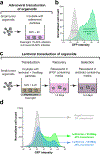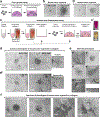Organotypic culture assays for murine and human primary and metastatic-site tumors
- PMID: 32690957
- PMCID: PMC8202162
- DOI: 10.1038/s41596-020-0335-3
Organotypic culture assays for murine and human primary and metastatic-site tumors
Abstract
Cancer invasion and metastasis are challenging to study in vivo since they occur deep inside the body over extended time periods. Organotypic 3D culture of fresh tumor tissue enables convenient real-time imaging, genetic and microenvironmental manipulation and molecular analysis. Here, we provide detailed protocols to isolate and culture heterogenous organoids from murine and human primary and metastatic site tumors. The time required to isolate organoids can vary based on the tissue and organ type but typically takes <7 h. We describe a suite of assays that model specific aspects of metastasis, including proliferation, survival, invasion, dissemination and colony formation. We also specify comprehensive protocols for downstream applications of organotypic cultures that will allow users to (i) test the role of specific genes in regulating various cellular processes, (ii) distinguish the contributions of several microenvironmental factors and (iii) test the effects of novel therapeutics.
Figures









References
Publication types
MeSH terms
Grants and funding
LinkOut - more resources
Full Text Sources
Medical

